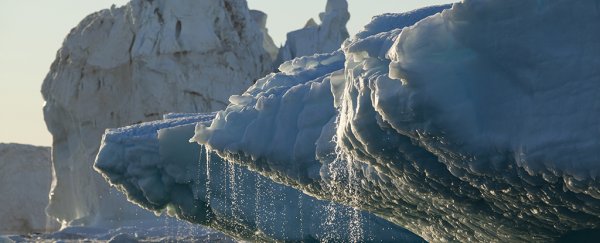As the polar ice sheets melt, the process is not just raising sea levels – it's also warping the underlying surface of Earth, a new study reveals, and some of the effects can be seen across thousands of miles.
What's happening is that Earth's crust is rising and spreading as the weight of the ice across Greenland, Antarctica, and the Arctic Islands gets lifted. The movement isn't huge, averaging less than a millimeter a year, but it's there and it covers a lot of ground.
There's a feedback loop happening too, because as the bedrock under the ice shifts, that in turn affects how the ice continues to melt and break away. A full understanding of how this works is essential in modeling how our world might look in the future.
"Scientists have done a lot of work directly beneath ice sheets and glaciers," says geophysicist Sophie Coulson, from Los Alamos National Laboratory in New Mexico.
"So they knew that it would define the region where the glaciers are, but they hadn't realized that it was global in scale."
Several previous studies have documented the uplift that can happen as ice sheets melt, but Coulson and her colleagues looked more closely at horizontal shifts, and across a wider area. They found that the deformations can vary significantly from year to year.
In some areas, the horizontal movement actually exceeds the vertical movement, the researchers found. They used satellite data and field measurements covering the years 2003 to 2018 to measure crust movement in three dimensions.
These crust rebounds can actually take thousands of years – the study notes that some changes are still being felt across Earth's surface from the end of the last ice age, some 11,000 years ago.
"On recent timescales, we think of Earth as an elastic structure, like a rubber band, whereas on timescales of thousands of years, Earth acts more like a very slow-moving fluid," says Coulson.
"Ice age processes take a really, really long time to play out, and therefore we can still see the results of them today."
The researchers compare the effect of the ice pack to a wooden board being pushed down on water: when the board is removed, and the weight is gone, the liquid expands to fill the available space, and the same happens with Earth's crust.
And with the rate of ice melt continuing to increase across the globe, it's important that scientists are able to figure out what impact it's having on the shape of Earth's surface, even if the shifts are relatively small each year.
This new study gives us more detailed data on what's happening than we've ever had before – and that's useful not just for studying melting ice and shifts in the Earth's shape, but also for many other fields of scientific study.
"Understanding all of the factors that cause movement of the crust is really important for a wide range of Earth science problems," says Coulson.
"For example, to accurately observe tectonic motions and earthquake activity, we need to be able to separate out this motion generated by modern-day ice-mass loss."
The research has been published in Geophysical Research Letters.
